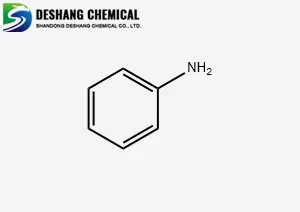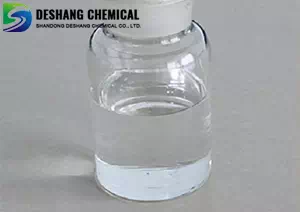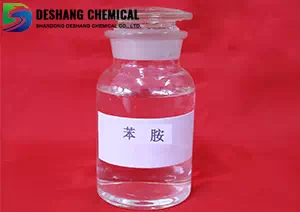



Aniline CAS 62-53-3, Aniline, CAS 62-53-3
Aniline CAS 62-53-3 is the simplest primary aromatic amine. It is a compound formed by the substitution of one hydrogen atom in the benzene molecule with an amino group.
CAS : 62-53-3
Formula : C6H7N
Mol. wt. : 93.13
EINECS : 200-539-3
| CAS | 62-53-3 |
| Molecular formula | C6H7N |
| Molecular weight | 93.13 |
| EIENCS | 200-539-3 |
| Form | Liquid |
| Melting point | -6 °C (lit.) |
| boling point | 184 °C (lit.) |
| Density | 1.022 g/mL at 25 °C (lit.) |
| Solubility | 36 g/L (20 ºC) |
| PKA | / |
| Color | APHA:≤250 |
| Storage temp | 2-8°C |
Aniline is the simplest primary aromatic amine. It is a compound formed by the substitution of one hydrogen atom in the benzene molecule with an amino group. It is a colorless, oily, flammable liquid with a strong odor. Melting point: -6.3℃, boiling point: 184℃, relative density: 1.0217(20/4℃), refractive index: 1.5863, flash point (open cup) : 70℃, autoignition point: 770℃, decomposes when heated to 370℃, slightly soluble in water, readily soluble in organic solvents such as ethanol, ether, and chloroform. It turns brown when exposed to air or sunlight. Steam distillation can be used, and a small amount of zinc powder should be added during distillation to prevent oxidation. After purification, aniline can be added with 10 to 15ppm of NaBH4 to prevent oxidation and deterioration. Aniline solution is alkaline and readily forms salts with acids. The hydrogen atoms on its amino group can be replaced by alkyl or acyl groups to form secondary or tertiary anilines and acyl anilines. When substitution reactions occur, ortho and para substitution products are mainly formed. It reacts with nitrous acid to form diazonium salts, from which a series of derivatives of benzene and azo compounds can be made.
Aniline is an important chemical raw material, with over 300 significant products produced. It is mainly used in MDI, the dye industry, medicine, and as a rubber vulcanization accelerator, such as para-aminobenzenesulfonic acid in the dye industry and N-acetylaniline in the pharmaceutical industry. It is also a raw material for manufacturing resins and coatings. In 2008, the consumption of aniline was approximately 360,000 tons. It is estimated that the demand in 2012 will be around 870,000 tons, while the production capacity of commercial aniline has reached 1.37 million tons, leaving nearly 500,000 tons of capacity. Aniline is highly toxic to the blood and nerves and can be absorbed through the skin or cause poisoning through the respiratory tract. There are mainly two methods for the industrial production of aniline: 1. It is prepared by hydrogenation of nitrobenzene catalyzed by active copper. This method can be used for continuous production and is pollution-free. Chlorobenzene and ammonia react at high temperature in the presence of a copper oxide catalyst to obtain it. This information was edited and compiled by Xiaonan from ChemicalBook (February 6, 2020).
Aniline is one of the most important intermediates in the dye industry and a major raw material for pharmaceuticals, rubber accelerators, and antioxidants. It can also be used to produce fragrances, varnishes, and explosives, etc. Aniline is used in the manufacture of dyes, medicines, resins, varnishes, perfumes, vulcanized rubber and even solvents. Dangerous and harmful substances that affect the early life stages of Marine animals. According to the United States Environmental Protection Agency (EPA), candidate compound 3 for environmental and food pollutants and drinking water pollutants (CCL3).
Aniline is an important raw material for the production of pesticides. From aniline, N-alkylaniline, alkylaniline, o-nitroaniline, o-phenylenediamine, phenylhydrazine, cyclohexylamine, etc. can be derived. It can be used as a fungicide such as sodium dimethoate, seed salicide, methicylamine, carbendazim, pyrimethanil, and benomyl, as well as an insecticide such as triazepam, pyrimazine, and quinazepam. Intermediates of herbicides such as metochlor, acetochlor, butochlor, cycloazinone, and imidazolinolinic acid.
Aniline is an important intermediate. There are over 300 important products produced from aniline. There are approximately 80 aniline manufacturers worldwide, with an annual total production capacity exceeding 2.7 million tons per year and an output of about 2.3 million tons. The main consumption area is MDI, and its consumption accounted for approximately 84% of the total aniline consumption in 2000. Aniline in China is mainly consumed in MDI, dye industry, rubber additives, medicine, pesticides and organic intermediates, etc. In 2000, the consumption of aniline was 185,000 tons. The production was insufficient to meet the demand, and imports had to be relied upon to solve the problem. Aniline series intermediates and dye products include: 2, 6-diethylaniline, N-acetylaniline, p-butylaniline, o-phenylenediamine, diphenylamine, diazo-aminobenzene, 4,4' -diamino-triphenylmethane, 4,4' -diamino-diphenylcyclohexylmethane,N, N-dimethylaniline, N-ethylaniline,N, N-diethylaniline,N, n-dipropyl aniline, p-acetamylphenol, p-aminophenone,4 4' -diethylaminobenzophenone,4- (p-aminobenzene) butyric acid, p-nitroaniline, N-nitrosodiphenylamine, β -acetaniline, 1, 4-diphenylaminourea, 2-phenylindole, p-phenylaniline, N-formyl aniline, n-benzoyl aniline, n-acetaniline, 2,4, 6-trichloroaniline, p-iodoaniline 1-aniline-3-methyl-5-pyrazolone, hydroquinone, dicyclohexylamine, 2- (N-methylaniline) propionitrile, 3- (n-ethylaniline) propionitrile, 2- (n-ethylaniline) ethanol, p-amino-azobenzene, phenylhydrazine, monophenylurea, diphenylurea, p-thiocyananiline, 4,4' diphenylmethane diisocyanate, polyphenyl polymethyl polyisocyanate Cyanate, 4-amino-acetaniline, N-methyl-N - (β -hydroxyethyl) aniline, n-methyl-N (β -chloroethyl) aniline,N, N-dimethyl-p-phenylenediamine,N,N,N',N' -tetramethyl-p-phenylenediamine,N, N-diethyl-p-phenylenediamine, 4,4' -methyl-bis (N, N-diethylaniline), phenylthiourea, diphenylthiourea, p-amino Benzenesulfonic acid, 4,4' -diamino-diphenylmethane benzoquinone,N, N-diethanolaniline, acetylacetaniline, p-aminophenol, N-ethylbenzyl aniline, N-methylformyl aniline, N-methylacetaniline, p-bromoacetaniline, bis (p-aminocyclohexyl) methane, phenylhydrazone diphenylcarbazone, acetophenone phenylhydrazone, aniline-2, 4-disulfonic acid, p-amino-azobenzo-4 Sulfonic acid, phenylhydrazine-4-sulfonic acid, thioacetaniline, 2-methylindole, 2, 3-dimethylindole, n-methyl-2-phenylindole
As a weak base, it can precipitate the easily hydrolyzable salts of trivalent and tetravalent elements (Fe3+, Al3+, Cr3+) in the form of hydroxides, thus separating them from the salts of the difficult-to-hydrolyze divalent elements (Mn2+). In picocrystalline analysis, it is used to test elements (Cu, Mg, Ni, Co, Zn, Cd, Mo, W, V) that can form thiocyanate complex anions or other anions (all of which can be precipitated by aniline). Test halogens, chromates, vanadates, nitrites and carboxylic acids. Solvent. Organic synthesis, dye manufacturing
Category
Toxic substances
Toxicity classification
Highly toxic
Acute toxicity
Oral administration - Rat LD50:250 mg/kg; Oral administration - Mouse LD50:464 mg/kg
Stimulus data
Skin - Rabbit 20 mg /24 hours moderate; Eye - Rabbit 20 mg /24 hours Moderate Explosive Chemicalbook Hazardous Characteristics: Explosive When mixed with air; It reacts vigorously with oxidants
Flammable hazardous characteristics
Open flames, high temperatures and strong oxidants are flammable. High heat decomposes toxic nitrogen oxide gases
Storage and transportation characteristics
The warehouse is well-ventilated, low-temperature and dry. Store separately from oxidants and food additives
* Prompt reply and 24 hours online, professional team to provide best price and high quality product.
* Sample testing support.
* Every batch of products will be tested to ensureits quality.
*The packing also can be according the customers` requirment.
*Any inquiries will be replied within 24 hours.
*we provide Commerical Invoice, Packing List, Bill of loading, COA , Health certificate and Origin certificate. If your markets have any special requirements, let us know.